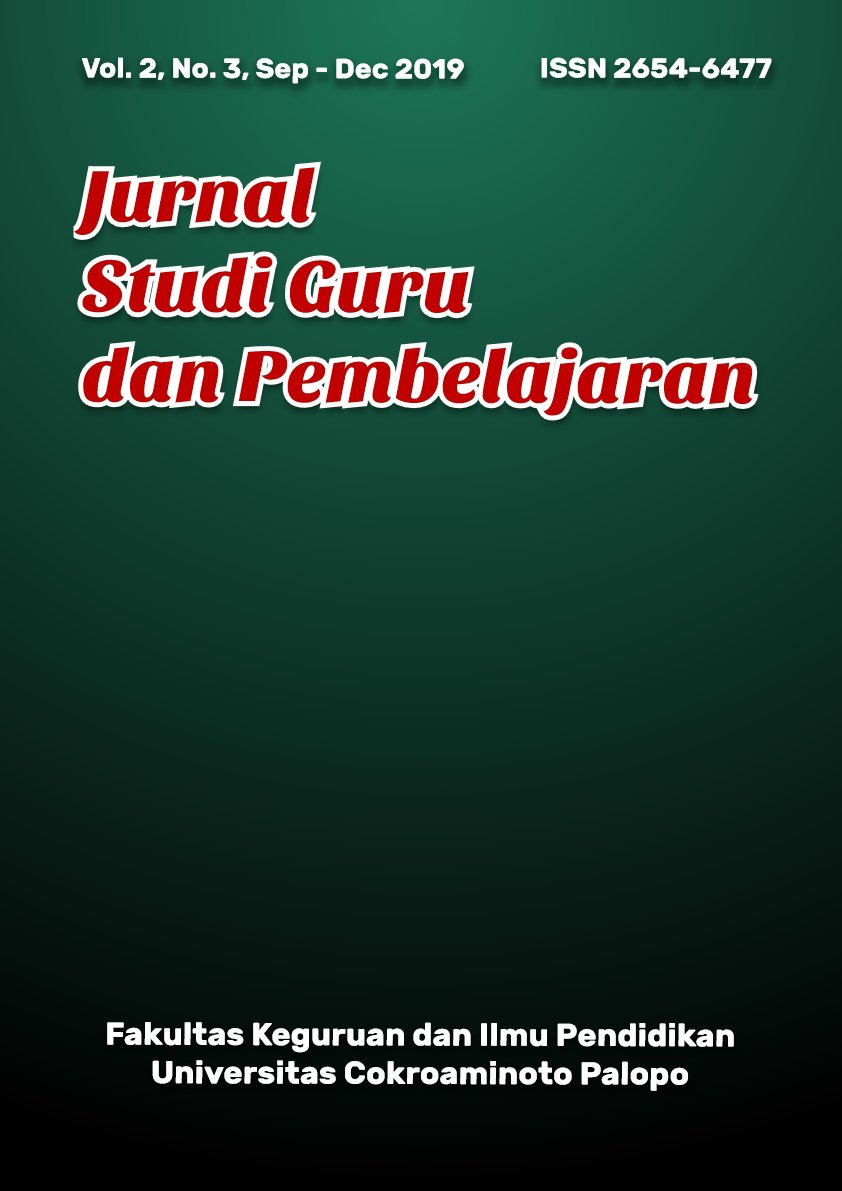Critical Thinking of Female Students in Solving Mathematical Problems
DOI:
https://doi.org/10.30605/jsgp.2.3.2019.2Keywords:
critical thinking, mathematical problem, female, case studyAbstract
Higher order thinking skill is a topic which attracts more attention of researchers in education field. Critical thinking belongs to higher order thinking skills. This kind of thinking should be had by everyone. Critical thinking belongs to 21st century skills Solving real world-mathematical problem regularly is assumed as one of ways encouraging one to grow and to enhance his critical thinking. A person who has good critical thinking skill in solving mathematical problems is considered to also think critically well in living his daily life. This study aims to investigate the critical thinking skill of female students consisting of ability in giving argument, drawing conclusion, and evaluating conclusion. A case study was carried out to four female students who were recruited based on their volunteering. Their critical thinking skills were evaluated by using essay test and interview. Participants’ critical thinking in solving mathematical problems is classified into high, medium, or low level. FS-1 and FS-4 are classified as low-level critical thinker. FS-2 and FS-3 are classified as high-level critical thinker. It is recommended to conduct similar study with larger sample involving both male and female students to compare their critical thinking in solving mathematical problems.
Downloads
References
Arviana, R. (2018). Problem Based Learning in Mathematics Education and Its Effect on Students’ Critical Thinking. Advanced Science Letter, 24(1), 211-213. https://doi.org/10.1166/asl/2018.11962
Butterworth J., Thwaites, G. (2013). Thinking Skills: Critical Thinking and Problem Solving. Cambridge: Cambridge University Press.
Chukwuyenum, A. N. (2013). Impact of Critical thinking on Performance in Mathematics among Senior Secondary School Students in Lagos State. Journal of Research & Method in Education, 3(5), 18–25.
Fahim, M., Eslamdoost, S. (2014). Critical thinking: Frameworks and models for teaching. English Language Teaching, 7(7), 141–151. https://doi.org/10.5539/elt.v7n7p141
Fisher, A. (2001). Critical Thinking: An Introduction. Cambridge: Cambridge University Press.
Franco, A. R., Costa, S., Butler, H. A. (2017). Assessment of Undergraduates’ Real-World Outcomes of Critical Thinking in Everyday Situations. Psychological Reports, 120(4). https://doi.org/10.1177/0033294117701906
Gambrill, E., Gibbs, L. (2017). Critical Thinking for Helping Professionals: A Skill-Based Workbook Fourth edition. New York: Oxford University Press.
Halpern, D. F. (2014). Thought and Knowledge: An Introduction to Critical Thinking 5th edition. Sussex: Psychology Press.
Hendriana, H., Rohaeti, E. E., Sumarmo, U. (2017). Hard Skills dan Soft Skills Matematik Siswa. Bandung: Refika Aditama.
Hyde J. S., Lindberg, S. M., Linn, M. C., Ellis, A. B., Williams, C. C. (2008). Gender similarities characterize math performance. Science, 321, 494–495. https://doi.org/10.1126/science.1160364
Kapitanoff, S., Pandey, C. (2017). Stereotype threat, anxiety, instructor gender, and underperformance in women. Active Learning in Higher Education, 18(3), https://doi.org/10.1177/1469787417715202
Kettler, T. (2014). Critical Thinking Skills Among Elementary School Students: Comparing Identified Gifted and General Education Student Performance. Gifted Child Quarterly, 58(2), https://doi.org/10.1177/0016986214522508
Lau, J. Y. F. (2011). An Introduction to Critical Thinking and Creativity: Think More, Think Better. New Jersey: John Wiley & Sons Inc.
Lombardi, A. R., Kowitt, J. S., Staples, F. E. (2015). Correlates of Critical Thinking and College and Career Readiness for Students with and Without Disabilities. Career Development and Transition for Exceptional Individuals, 38(3), https://doi.org/10.1177/2165143414534888
Moore, B. N., Parker, R. (2012). Critical Thinking 10th edition. New York: McGraw Hill Companies, Inc.,
Rainbolt, G. W., Dweyer S. L. (2012). Critical Thinking: The Art of Argument. Boston: Wadsworth.
Song, X. (2016). “Critical Thinking” and Pedagogical Implications for Higher Education. East Asia, 33(1), 25–40. https://doi.org/10.1007/s12140-015-9250-6
Spencer, S. J., Steele, C. M., Quinn, D. M. (1999). Stereotype threat and women’s math performance. Journal of Experimental Social Psychology, 35, 4–28.
Steele, C. M., Aronson, J. (1995). Stereotype threat and the intellectual test performance of African Americans. Journal of Personality and Social Psychology, 69(5), 797–811.
Steele, C. M. (2010). Whistling Vivaldi: How Stereotypes Affect Us and What We Can Do. New York: W. W. Norton & Company.
Watson, G., & Glaser, E. M. (1980). Critical thinking appraisal: Manual. New York: Psychological Corporation.
Downloads
Published
How to Cite
Issue
Section
License
In submitting the manuscript to the journal, the authors certify that:
- They are authorized by their co-authors to enter into these arrangements.
- The work described has not been formally published before, except in the form of an abstract or as part of a published lecture, review, thesis, or overlay journal.
- That it is not under consideration for publication elsewhere,
- That its publication has been approved by all the author(s) and by the responsible authorities – tacitly or explicitly – of the institutes where the work has been carried out.
- They secure the right to reproduce any material that has already been published or copyrighted elsewhere.
- They agree to the following license and copyright agreement.
License and Copyright Agreement
Authors who publish with JSGP agree to the following terms:
- Authors retain copyright and grant the journal right of first publication with the work simultaneously licensed under Creative Commons Attribution License (CC BY-SA 4.0) that allows others to share the work with an acknowledgement of the work's authorship and initial publication in this journal.
- Authors are able to enter into separate, additional contractual arrangements for the non-exclusive distribution of the journal's published version of the work (e.g., post it to an institutional repository or publish it in a book), with an acknowledgement of its initial publication in this journal.
- Authors are permitted and encouraged to post their work online (e.g., in institutional repositories or on their website) prior to and during the submission process, as it can lead to productive exchanges, as well as earlier and greater citation of published work.














